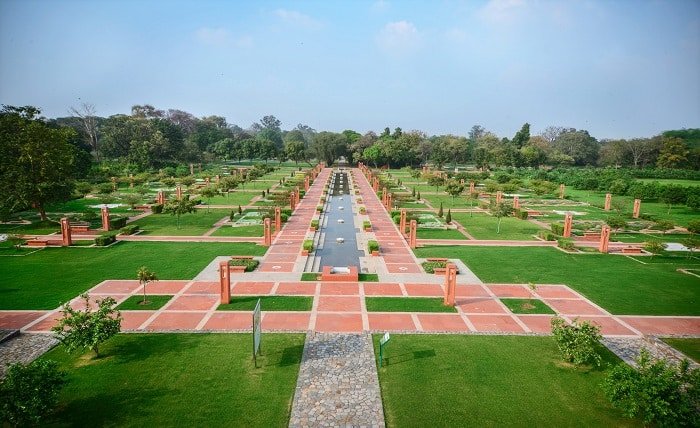Sunder Nursery: A Beautiful Garden in the Heart of Delhi

Located in the heart of Delhi, Sunder Nursery is a stunning 90-acre heritage park that seamlessly blends nature, history, and architecture. The park has become one of the city’s most celebrated attractions, offering a peaceful retreat from the hustle and bustle of urban life. As an urban oasis, it attracts both nature lovers and history enthusiasts, providing an ideal space for relaxation, exploration, and cultural enrichment. The charm of Sunder Nursery lies not just in its sprawling green spaces but in its remarkable history and the significant role it plays in preserving Delhi’s rich heritage.
Whether you’re interested in exploring botanical wonders, learning about India’s architectural history, or simply relaxing amidst serene surroundings, Sunder Nursery offers something for everyone. In this blog post, we will explore the history, significance, and highlights of Sunder Nursery, along with tips for visiting this beautiful heritage park.
The History of Sunder Nursery
Origins of Sunder Nursery
Sunder Nursery has a fascinating history that dates back to the Mughal era. Originally a part of the gardens surrounding the Humayun’s Tomb complex, Sunder Nursery was once a private garden belonging to the Mughal emperors. The Mughal emperors, known for their love for gardens, developed vast, lush spaces, and Sunder Nursery was no exception. The area was originally part of a larger horticultural project meant to enhance the beauty of the surrounding Mughal structures, particularly the iconic Humayun’s Tomb.
Sunder Nursery’s significance grew as it became intertwined with the Mughal legacy. The area’s botanical diversity, strategic placement, and cultural value made it a valuable part of Delhi’s heritage. In modern times, Sunder Nursery has been carefully preserved and restored, ensuring that it remains a symbol of Delhi’s rich history and cultural diversity.
Restoration and Conservation Efforts
In recent years, Sunder Nursery has undergone extensive restoration efforts. The park is now part of a larger conservation project that seeks to preserve the rich historical, architectural, and ecological value of the site. One of the key elements of the restoration process was the renovation of the park’s historic Mughal-era structures. These structures include ancient tombs, pavilions, and gateways, which are important remnants of the Mughal Empire.
The conservation work carried out in Sunder Nursery was aimed at revitalizing the park’s botanical diversity and historical architecture. The restoration process adhered to the guidelines of the Archaeological Survey of India and other conservation authorities, ensuring that the park retains its historical integrity while introducing modern amenities to enhance visitor experience.
Sunder Nursery as a UNESCO World Heritage Site
Sunder Nursery and the World Heritage List
In recognition of its historical and cultural significance, Sunder Nursery was inscribed as a UNESCO World Heritage Site. The park’s inclusion on the World Heritage List is a testament to its importance as a cultural and ecological landmark in Delhi. Sunder Nursery is now recognized not only for its natural beauty but also for its contributions to preserving India’s architectural heritage.
The UNESCO World Heritage designation helps protect and preserve the site for future generations, ensuring that it remains an integral part of India’s cultural and historical landscape. The site is now a key point of interest for tourists from all over the world, with many people visiting to learn about its fascinating history and admire its lush gardens.
The Importance of Sunder Nursery in Heritage Conservation
Sunder Nursery’s World Heritage status places it among some of the most significant cultural sites globally. Its role in heritage conservation goes beyond its status as a park—it is a living testament to Delhi’s evolving history and urban development. The nursery plays a crucial role in educating visitors about the importance of heritage conservation and how cultural landmarks can coexist with modern urban life.
Moreover, the park’s efforts to balance ecological preservation with historical conservation serve as a model for other urban spaces worldwide. Sunder Nursery’s careful blend of nature and history encourages a deeper appreciation of both the environment and the cultural landmarks that shape our cities.
The Beauty of Sunder Nursery: A Blend of Nature and History
Lush Gardens and Botanical Diversity
One of the highlights of Sunder Nursery is its incredible botanical diversity. The park features an extensive collection of indigenous and exotic plants, making it a haven for nature lovers and botanists alike. The nursery is home to a variety of trees, flowering plants, shrubs, and herbs, each contributing to the vibrant landscape.
Visitors to Sunder Nursery can enjoy walking through different sections of the park, each offering a unique experience. Whether it’s the fragrance of jasmine, the sight of blooming flowers, or the shade of ancient trees, the nursery provides a sensory experience that connects visitors to the natural world. The careful curation of plant species also ensures that the park remains ecologically balanced and sustainable, providing habitat for local wildlife.
The botanical gardens at Sunder Nursery are not only a visual treat but also serve as an educational resource. The park’s dedicated efforts to preserve and promote native plant species help increase awareness about biodiversity and the importance of conservation.
Historical Monuments and Architecture
In addition to its botanical wonders, Sunder Nursery is home to several historical monuments that add to its allure. These structures, many of which date back to the Mughal era, include tombs, gateways, and pavilions. These architectural marvels reflect the grandeur of the Mughal Empire and its contribution to India’s cultural landscape.
Some of the most notable structures within Sunder Nursery include the tomb of Azam Khan, a noble in the Mughal court, and the Bagh-i-Muazzam tomb. The architectural style of these tombs is characteristic of the Mughal era, with intricate carvings, domes, and arched doorways. These structures are beautifully integrated into the surrounding gardens, enhancing the overall experience of visiting Sunder Nursery.
The Humayun’s Tomb Complex
One of the key historical features of Sunder Nursery is its proximity to the Humayun’s Tomb, a UNESCO World Heritage Site in its own right. Humayun’s Tomb, built in the 16th century, is considered one of the finest examples of Mughal architecture and is a precursor to the Taj Mahal. The relationship between Sunder Nursery and Humayun’s Tomb is crucial in understanding the historical significance of the park.
The gardens surrounding Humayun’s Tomb are linked with the landscaping of Sunder Nursery, which was designed to complement the tomb’s grand design. As visitors stroll through the park, they can explore the architectural beauty of both the tomb and the surrounding gardens, providing a glimpse into Mughal-era landscaping and architectural principles.
Activities and Experiences at Sunder Nursery
A Peaceful Retreat in the City
Sunder Nursery is not just a historical and botanical site; it’s also a perfect place to unwind and relax. With its lush gardens, scenic landscapes, and tranquil atmosphere, the park offers an oasis of calm amidst the bustling city of Delhi. Whether you’re looking to take a leisurely walk, meditate in a quiet corner, or simply enjoy a picnic with friends and family, Sunder Nursery provides a peaceful environment that allows visitors to escape the noise of city life.
Exploring the Nursery’s Ecological Efforts
For those with an interest in sustainability and environmental conservation, Sunder Nursery is a great place to learn about ecological efforts in urban spaces. The park is actively involved in planting native species and ensuring the sustainability of its flora and fauna. Guided tours and educational programs help raise awareness about conservation and the vital role that parks like Sunder Nursery play in maintaining ecological balance.
The nursery’s commitment to environmental education is evident in the park’s numerous initiatives, such as tree plantation drives and educational workshops. Visitors can engage in activities that promote awareness of sustainable gardening practices and the importance of preserving local ecosystems.
A Photographer’s Paradise
Sunder Nursery is also a paradise for photographers, offering countless opportunities to capture the beauty of nature, architecture, and history. Whether you’re capturing the intricate details of Mughal architecture or the sweeping vistas of the park’s botanical gardens, Sunder Nursery provides a rich and diverse canvas for photographers. The interplay of light and shadow in the park’s landscapes creates unique and stunning photo opportunities.
Visiting Sunder Nursery: Tips and Information
How to Reach Sunder Nursery
Sunder Nursery is located in the Nizamuddin area of South Delhi, easily accessible by car, public transport, and metro. The closest metro station is the Hazrat Nizamuddin Metro Station, which is just a short walk away from the nursery. Delhi’s well-connected road network ensures that reaching Sunder Nursery is hassle-free, whether you’re coming from central Delhi or nearby areas.
Opening Hours and Entry Fees
Sunder Nursery is open to visitors daily, with specific opening hours. The park generally opens early in the morning and closes in the evening, allowing visitors to enjoy the natural beauty at different times of the day. Entry fees are nominal, making it an affordable destination for tourists and locals alike. Special rates may apply for group bookings or educational tours, so it’s advisable to check the official website for the latest information.
Best Time to Visit Sunder Nursery
The best time to visit Sunder Nursery is during the cooler months of the year, typically between October and March. This is when the weather is most pleasant, making it ideal for long walks, picnics, and exploration. However, Sunder Nursery is open year-round, so visitors can enjoy its beauty at any time, although the summer months may be more challenging due to the heat.
Conclusion
Sunder Nursery is a perfect blend of history, culture, and nature, making it one of Delhi’s most cherished heritage sites. Whether you are a nature enthusiast, a history buff, or simply someone looking for a peaceful retreat, Sunder Nursery offers a unique experience. From its Mughal-era architecture to its lush gardens, every corner of the park tells a story, inviting visitors to explore and appreciate the rich heritage of Delhi.
As a UNESCO World Heritage Site, Sunder Nursery is not just a place to visit but a site to cherish and protect for future generations. Its efforts to conserve both the environment and history set it apart as a model for other heritage sites in the world. Visiting Sunder Nursery is not just an opportunity to experience beauty and history but also a chance to participate in the ongoing journey of preservation and appreciation.
FAQs
1. What is Sunder Nursery?
Sunder Nursery is a 90-acre heritage park in Delhi, blending nature, history, and architecture. It is a popular destination for tourists and locals alike, known for its Mughal-era monuments and lush botanical gardens.
2. How can I reach Sunder Nursery?
Sunder Nursery is located near Hazrat Nizamuddin in South Delhi. The nearest metro station is Hazrat Nizamuddin, and the park is also accessible by car and public transport.
3. What is the significance of Sunder Nursery?
Sunder Nursery holds historical significance as part of the Mughal-era gardens surrounding Humayun’s Tomb. It has been designated a UNESCO World Heritage Site due to its cultural and ecological value.
4. When is the best time to visit Sunder Nursery?
The best time to visit is between October and March when the weather is cool and pleasant. However, it is open year-round, and each season offers a unique experience.
5. Are there any fees to visit Sunder Nursery?
Yes, there is a nominal entry fee for visitors. Special rates may apply for group bookings and educational tours, so it’s best to check the official website for updated pricing information.





